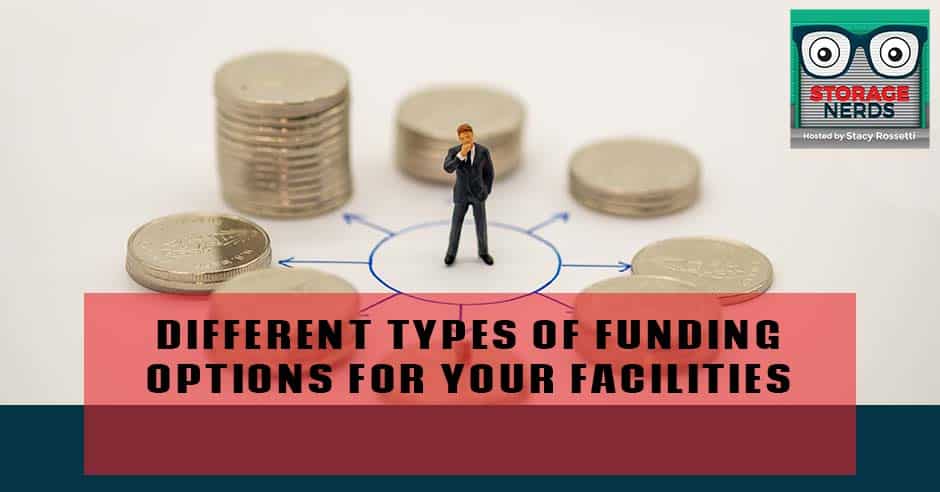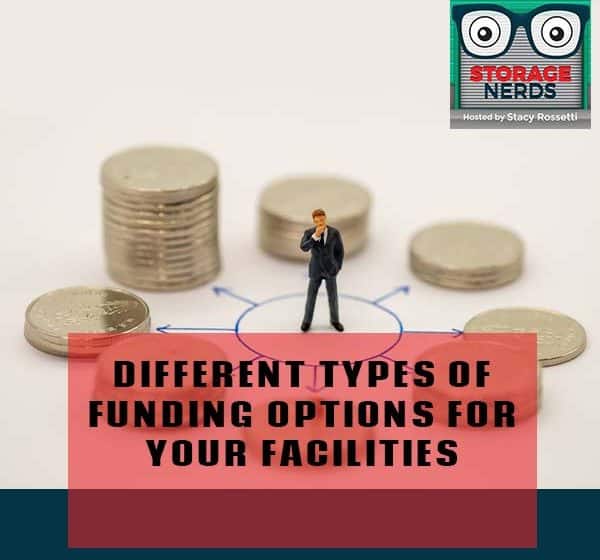
Eager to start investing in self-storage facilities but not quite sure how to get the funds? In this episode, Stacy Rossetti shares the different funding options you can use to close your deal! Learn how you can raise money through loans, partnerships, wholesaling, or owner financing. Plus, learn how the type of facility you are interested in buying may impact your funding options.
—
Watch the episode here:
Listen to the podcast here
Different Types Of Funding Options For Your Facilities
What we are going to talk about is something that is super important. I talked to a couple of people on my coaching call and they had some questions about this, so I figured I would go over this topic to help everybody to try to figure out what your options are when you do get started in self-storage and that topic is going to be funding. We’re going to talk about how to fund your deals. Everybody’s always worried about the money and where the money is going to come from. What I figured we would do is talk about that.
Thank you so much for coming and hanging out with me. I own eleven storage facilities in the Georgia and Florida area. On top of that, I teach people how to invest in self-storage. I focus on mom and pop, get your foot in the door facilities. Everybody’s got to start somewhere and that’s the truth. I’m here to get you started, answer all those questions and try to get the fear of getting started on your mind because if I can do it, anybody can do it. Everybody always says that but essentially, it’s true.
We have a couple of people. Randy has been doing multifamily now and he’s looking to invest in self-storage. Also, Andrew is in Atlanta. I’m also from Atlanta. “We don’t know each other personally, but we’re friends on Facebook.” Thanks for coming to hang out with us. “I’m not new to investing, but I’m new to storage facilities.” Thank you for hanging out, Andrew. I appreciate that, Randy’s from Colorado.
We’ve got a whole bunch of students as well. We did the two-day bootcamp for StorageNerds, which was fun. We did find them, did analysis and onboarding, how to onboard your facility. We also did some management stuff, how to manage your facilities. We also did how-to-build-your-brand-online because the truth of the matter is that nobody ever thinks about this.
When you get into self-storage investing, you’re actually buying a business. In the back end, you have to be able to run it.
When you get into self-storage investing, you’re buying a business and in the backend, you have to be able to run it. It’s a business. Being able to find tenants and manage those tenants is probably one of the most important parts of investing in self-storage. Everybody is always asking, “How do I find them? How do I fund them? Is this a good deal?” In the end, the truth is it’s a good deal if you can manage it properly. That’s it.
What I’m going to do is I’m going to get into funding, all the different types of bills out there, how you can fund them and what are the best ways to fund them. That is going to be the topic and then we can get into the money. Does anybody know any of the ways that you can invest in self-storage? There are six different ways that you can invest in self-storage. If you’ve been following me for a while, you probably know all of these or some of these. One of the main reasons why I love investing in self-storage is because there are so many different opportunities out there and people don’t think of all of them but I want to make sure that everybody knows what those are.
First things first, what we’re going to do is we’re going to talk about the six different ways for you to invest in self-storage and then I’m going to tell you of all the six ways, how to fund that type of deal. I’ve said this many times to my students. It’s not the only way, but it’s the best way. When you start getting out there, you start looking for storage facilities and talking to owners, the truth is you have no idea what’s going to come across your plate and what type of facility it is. What you have to do is educate yourself on the types of purchases out there so that you know when you do come across a certain type of facility how you should get the funding for that.
First, we’re going to talk about the types of facilities that I buy. If you are my student, you know what types of facilities I buy. I have eleven facilities. What type are they? Number one is mismanaged facilities. What this means is that it’s not managed properly. It doesn’t have to be dumpy. It doesn’t have to be ugly. A lot of them are dumpy and ugly if they’ve been mismanaged, but the truth of the matter is, a mismanaged property is not being properly managed.

SBA Loans
Mismanaged facilities are typically 75% full or less but you’re going to find them at 50% to 75% full. A mismanaged facility could be an abandoned facility. I’ve bought abandoned facilities before or a mismanaged facility could be 75% full. It’s creating income but it’s not being run properly or expect that you can value-add the property by increasing the rates. In the industry, a mismanaged property, when you ask the owner, “Is it full or not full? What’s your occupancy?” They say, “It’s about halfway full. It’s 75% full.” That in this industry nowadays is a gray area on what type of financing you can get.
SBA is open to funding a mismanaged facility that’s 50% or more as long as they know that over the last year, it’s been increasing income. If anybody doesn’t know what SBA is, it’s the Small Business Administration. SBA loves storage facilities and they love loaning on storage facilities. They like facilities that are income-producing properties, which is the next one. You know now that the SBA is going to loan on an income-producing property or a mismanaged facility. With a mismanaged facility, they want to have proof of income.
For instance, one of my students bought a facility in Texas where it was a brand new facility that was done and the owner built it and then he sold it off. When my student bought it, there was no income. That’s not a mismanaged facility per se, but it’s a facility that doesn’t have any income. If your facility does not have income, then it’s hard to go to a bank and get a loan because, in the commercial real estate world, everything is based on income. That’s what the banks want to see. They want to see how much income that facility is producing. If it’s not producing any income, if there’s no cashflow, then they’re not going to lend on it.
In mismanaged facilities, it’s a gray area if it’s 50% to 75% full. SBA has typically lent on a mismanaged facility if you can prove that for a certain amount of time you are leasing that place up, you are creating more income and you can show that it’s building income over time. SBA is more open to renting because I do have students that are purchasing properties where they are 60% full and over the last year, they were not full at all. They’re just being leased up.
Private lenders are there to lend you money at high interest rates.
In terms of the student, I told you about who bought this brand new facility that had no income at all, what he did is he had to borrow private money from one of my lenders. They funded it and they gave him eighteen months to lease the property up. In eighteen months, he can refi it out with either a bank loan or an SBA loan.
Raising Private Money: Banks and Private Lenders
With a mismanaged facility, if it’s producing income and it’s in that gray area, you can go to SBA. If it’s a truly mismanaged facility where it’s not being managed properly and it’s not producing the income that it should be, then you are going to have to find private lenders. Private lenders can be somebody that offers to lend you the money.
For instance, on the one where my student bought this property that was brand new, he bought it for $1 million and one of my private lenders lent him the money for the property. He put $200,000 down. They required 20% down. They gave him a note for 9% interest and they gave him $800,000. It was an $800,000 note at 9% interest for eighteen months.
Passive Earning Through Lending
That type of note gave him enough time to lease the property out and get it all leased up. It’s able to give him enough time to find another lender that will finally loan to him at a regular interest rate after he has got that thing up and running. That’s what private lenders do. Private lenders are there to lend you money at high-interest rates, anywhere from 6% to 12%, depending on your experience and the lender themselves and stuff.
This was my student’s first deal and my lender was generous and gave him 9% interest. You don’t want to hold on to 9% interest forever. Also, that loan was an interest-only loan. They’re not amortizing that note over eighteen months. They were just like, “This is an interest-only loan. Pay me for eighteen months. At the end of the eighteen months, you’re still going to owe me the $800,000 that I lent to you.” That is what private lenders do. They’ll lend you the money at a higher interest rate for a shorter amount of time.
Private lenders are the perfect type of lender for a mismanaged facility. Everybody knows that I buy mismanaged facilities. That means they have to be privately funded. I am always raising money. I’m always pitching deals. In fact, I pitched three deals not too long ago. I am always looking for money for those deals. If you want to buy and mismanage properties, then you’re going to have to get very good at raising money.

In the commercial real estate world, you need to be good at raising money anyways. If you want to buy a mismanaged facility, then you have to get good at raising money. For income-producing properties, you still have to raise the money. When I say raise the money, I mean going and talking to the bank. That’s raising the money. Raising money doesn’t have to be just private money. It could also be bank loans but you’ve got to get good at talking to lenders and being open to asking people for money. I’ve gotten over the fear of doing that.
What I love about buying mismanaged facilities is that most of the time, I can 3X my money. I could buy something for a couple of hundred thousand dollars and in two years, it’s worth triple that amount of money. That’s why I love mismanaged facilities. You can typically do the same thing with new construction. That’s another way to invest in self-storage. These are the three most popular ways to invest in self-storage.
With new construction, you can also go to SBA and get a loan. SBA loves new construction loans just as long as the facility that you’re buying already is producing income and the market calls for a value-add of adding new units or the market calls for new construction. They love doing new construction loans. The reason I bring up SBA is because the requirement for a down payment on an SBA loan is anywhere from 10% to 20%, depending on how good the deal is.
Everybody has a different risk level. Everybody has a different amount of money.
That’s how commercial lenders look at their deals. It’s called asset-based lending. They are looking at the asset to see how good of a deal it is. If it’s a home run that you picked up like a kicker, then they could ask for 10% down, give you a great interest rate and a twenty-year loan. If it’s an okay deal where they know you’re going to be able to pay the mortgage and make a little money, then they may ask for 20% down and only give you a ten-year loan with a little bit higher interest rate.
With asset-based lending, you can’t say, “What are the terms of this loan?” It depends on the asset and how much that asset is valued by the bank, the lender or the SBA. With mismanaged facilities, you have to learn how to raise private money and how to talk to other people because if that facility is 50% full or less, then no bank is going to be lending you the money. You’ve got to get out there and you’ve got to pitch your deals and see if anybody wants to give you the money.
I have four storage facilities under contract. One of them I already have the money for. One of them I think I have the money for so we have two left. All of the ones that I have are all mismanaged facilities. Now, if one of the facilities that I have under contract is a $1 million property that’s making $150,000 a year, it doesn’t sound like an income-producing property. It’s 157 units and 20,000 square feet. We put it under contract for $1 million and it’s making $150,000. Why would it be considered a mismanaged property?
We got a couple of people. “How full is it? Are the rates at market?” It is 100% full and yes, the rates are at market. I’m going to increase them a little tiny bit, maybe $0.05 a square foot. “The value-add is missing?” No. “Bad records?” “Maybe not running a website marketing?” “Accounting?” Exactly. That is it. Good guesses. The owner only takes cash. That is what it is. He has treated this facility as a hobby. He has no proof of records. I asked him for his P&L and his balance sheet and he said, “What’s a balance sheet?” He had no idea even what a balance sheet was.

One of the things is that he’s saying he’s making $150,000 a year, but we have no proof of that at all. Would you buy this facility? Would you partner with this facility? I pitched out to the world that I’m looking for money for this deal, but I have no proof of $150,000 at all. The property is valued at $1.5 million. When we buy this thing, there’s already $500,000 in equity in the deal. What we’re going to have to do is hold on to it for two years because as soon as we get this thing, we’re going to start making money but we need those records.
We need to be able to show our P&L and balance sheet to a lender so that we can refi out later in two years. For now, I can’t prove that. I don’t have anything, so I have to find people to give me money and partner on the deal with me. That is also considered a mismanaged facility. There are a lot of facilities out there like this. I call that the hidden market or the sweet spot. It doesn’t take a lot of work, but it takes a lot of effort to find these facilities.
There are a lot of facilities out there like this because a lot of owners treat their facilities as hobbies. If they only have one type of facility, they’re like, “What’s the big deal?” He’s like, “I can give you my 2020 tax return, but it’s definitely not going to show all the money that I made from this facility.” This happens quite often. You have to get good at talking to private lenders and raising private money in order to purchase these types of facilities.
This facility is 157 units and it has ten acres, so there is room to grow. He said, “You could put as many facilities as you want. As we need to, we could do phases and grow and grow,” which is exactly what he did. He started out with 60 units and then he added another phase, which was another 100 units. Now he’s full and he’s been full, it’s time for phase three, which is going to be us coming in and adding units as well.
We could add units now and I could raise the money to go add the units or I can wait until we have tax returns and then go and get some money from a bank to borrow the money to get the loan, go to SBA get a loan and go to a local bank. With mismanaged facilities, you’re not going to be able to go to a local bank to get a loan because they’re not going to do it.
With income-producing properties and new construction, you always want to compare a local bank with a big SBA lender and compare what the terms are going to be because a lot of times, local banks have better terms than SBA. They may require a little bit more down, but the interest rate and the terms of the loan are going to be a lot better. If you find an income-producing property or you want to do some new construction, then I highly recommend that you talk to a local bank in the area where you want to do it and get their offers of what they would offer you for their terms as well.
When you talk to your partner, you have to figure out what their risk level is, what their exit strategy is, what their goal is., what their outcomes are.
Partnerships: Equity Splits, Asset management, and Syndications
We now have three different types of facilities. We have mismanaged facilities, income-producing and new construction. With new construction, you can go to SBA or local banks. With income-producing properties, you can go to SBA or local banks. On all of these, you could always partner and raise the money. It doesn’t have to be a mismanaged facility in order for you to do some equity partnership. You can always raise money and then create a company, go out there and build a facility together or buy an income-producing property together.
Let’s say that you could get a loan from a bank. It is an income-producing property, it has a P&L, the balance sheet, and the owners are willing to give tax returns. The truth of the matter is I’ll buy mismanaged facilities, but I’m not going to sell those facilities until I know I can give two years of tax returns at the highest level I could possibly get them to. Also, my P&L and my balance sheet because I want to sell my facilities as income-producing properties. Your goal is to sell at the highest possible value that you can get it at, but you have to be able to show P&L, balance sheets and tax returns in order to do that.
We buy mismanaged facilities that in the next three years, we can sell them to somebody else and get the highest value we can get. With the mismanaged facilities, the exit strategy for us most likely is going to be to sell that facility and then 1031 exchange it to the profit that we make into a bigger deal. Several of my lenders say, “Please take my money with you. I don’t want the money back.”
One of my private lenders gives me quite a bit of money and does not want his money back. He’s making money on his money, so why would he want it back? We’ve discussed and I said, “Our loans are coming to term. Should I refi you out and pay you the money back? What should I do?” He’s like, “I don’t want my money back. If you’re going to sell it, then you need to take my money with you and we’re going to use that as a down payment.”
Once you start getting into the private lender world and truly learn how to raise money, this is what happens. You create these partnerships that are win-win situations for everybody and then they want to stay with you. Some of them will want the money back, which is fine, but some of them want you to keep working their money. With income-producing properties, you will get a P&L and a balance sheet. You’ll get all the things that you need in order to be able to sell it at top dollar. You will be getting that.

“Would a bank give you a loan on this?” No, a bank would not give me a loan. No P&L, no balance sheet, nothing. He doesn’t even file his tax returns on this thing. That’s what I’m saying. There’s no bank. He has nothing to prove that he’s making $150,000 a year. All we have to go off is his word. The truth is when I buy mismanaged facilities, I’m going off with people’s word and a lot of times, they’re lying to you.
He says he’s making $150,000. All of the units are full. Everybody’s full and we see his prices, so we know he’s making money. Maybe he’s making $100,000. I don’t think he’s $50,000 off, but maybe he’s not making exactly $150,000. He did it and wrote everything out for us. He said, “This is what I’m making. This is how it is.” He’s like, “I have nothing to show for it, but this is how it’s working out for me.” We take his word for it but at the same time, we know that maybe there’s a little bit of leeway in this that we’re not making that much.
In the beginning, it takes a couple of months to get everything up and running and for the income to come in anyway. I’ll be partnering on these facilities, so there will be no mortgage, which is one of the things that I love about partnering. In some situations, you partner and you could do a 50/50 split or however, you want to have more than the partner and then you have no mortgage on the facility.
We have partnerships where we partner and then we’ll manage the asset and they’ll bring the money or something like this. We partner based on how we work the terms out. I like partnerships because you have no mortgage. All that money every single month flows back into the company and then you build up this reserve. On a quarterly basis, you pay your partners out.
Let’s do partnerships. You could do equity split, asset management or debt. There are probably a million different ways, but this is the stuff that we do off the top of my head. In the partnerships, the way it works is somebody will say, “I’ll bring 50% to the table and you bring 50% and then we partner.” “I’ll bring 20%, you bring 80%, whatever the structure is and then we partner.” However the partnership works, you’ll work it out in your operating agreement and then you’ll get paid out on a regular basis for all the net income.
On the backend, when you sell the property, you get paid out based on that split and you distribute to the partners that way based on the profit. That would be an equity split and then the percentages could be any percentage in the work depending on how much you want to give. A lot of times, when you do a loan with a bank, I’ve done this before too. I’m going to say, “I’ll put some money into your deal.” I’ll partner with my students on their deals. I’ll say, “What’s the percentage that the bank offers?”
If you can find a good attorney or title company to help you close deals, you have a bold line.
That means that I don’t have to guarantee myself on the loan. It’s anywhere 19% or below, depending on the bank. It could be anywhere from a couple of percentages to 19%. Every bank is completely different. What my students will do is talk to the bank and say, “I have somebody that wants to put some money into the deal,” and get an equity split like, “What’s your threshold on that? What’s your percentage,” so that they don’t have to guarantee the loan. They’ll say 5% or 10% or 15% or 20%, whatever the number is. They’ll tell you what that is. I’ll know, “I could put this much in and this should be okay. I don’t have to worry about me being part of the deal.” I’m like somebody that puts money into the deal.
You couldn’t be like, “Everybody’s going to put 5% in and then we’re going to put 100 people.” You can’t do that because that’s pooling money and the banks are going to allow you to take a loan out if you have twenty people doing 5% or something. Partnerships are typically 50/50, 60/40, 70/30, 80/20, 90/10 and then you will have a couple of people that put in a little bit amount of money, at least that’s what I see.
If you want to start pooling money in, you want to get into funds and stuff like that. You have to register yourself and start a fund if you want to pool a whole bunch of money together. Partnerships are okay. Partnerships are a couple of people that get together and buy a property together. That is an equity split. You will have an operating agreement that spells out the terms of your partnership, who’s responsible for what and how you will put your exit strategy in things like this.
You could be the person in the deal that’s like, “No, I want to be the one that’s managing everything.” You could be the asset manager and you could say, “I’ll manage these assets and I want to get this much money.” We do this on a couple of our deals. We’re essentially asset managers and we’ll get a percentage of the deal for managing the asset and then they bring the money in. That’s asset management, too.
If you know somebody that has money, you’ll partner and be like, “You bring the money and I manage the asset and then I get a cut of a deal. How’s that?” That’s asset management. You would spell out the equity split in your operating agreement. In all of these, you would have an operating agreement, but the way that you would spell it out would be a little bit different. You can do asset management. We’re are not asset managers. We manage our own assets. It’s what we do.

There’s a couple of deals that we’re working on and looking at, where it’s like, “You bring the money and then we’ll get a cut of the deal. We’ll manage everything,” especially if you don’t want to put any money into the deal because I don’t put a lot of money into my deals. I’m okay with saying, “I want to own this asset. I want to be a part of this asset, but I’ll get a cut of it because I know I’m going to be managing it.” That’s asset management.
The way that you figure this out is because your partners or your lenders, the people that you talk to, all have different risk levels. Everybody has a different risk level. Everybody has a different amount of money. I’ve talked to a couple that has $700,000 and they’re trying to figure out what to do with their $700,000. I talked to another person that has $60,000.
I have some lenders who want a partner and some lenders who have a lien on the property and want to be a lender. When you talk to partners, you have to figure out what their risk level is, what their exit strategy is, what their goal is and what their outcomes are. With the preferred return, I have one person that I’m partnering with who would rather get a return on his money and have an equity split.
What we did for him is we gave him a certain interest rate on the money that he put into the deal and smaller equity splits. It’s the preferred return plus the equity split, which is what our fund does. In our fund, when you start a fund, you become an asset manager. That’s what it is. For our fund, we offer a preferred rate of return and a split in the deal. We get a cut as well too, for managing the assets. The preferred return is for somebody conservative but also a little bit open to the equity partnership.
Whereas for debt, I have lenders who are like, “I want to have debt on the property. I want to have a loan on the property. I want to be the first lien on the property. I need that security. I want to make sure if something happens, my money is safe and I can get that property. I need that lien on the property.” I have people like this who want the lien on the property. They lend me money and I pay them on a monthly basis. It’s either interest-only loans or sometimes amortized loans as well, too but they want that lien on the property.
Owner financing is another tool in your toolbox you can learn to fund your deals.
For the preferred rate of return or the asset management or the equity split, essentially, you’re creating an operating agreement depending on what the terms are that you come to a negotiation with and you are partnering on the deal. We now have mismanaged facilities, income-producing properties and new construction. We know that we could go to SBA for most of those types of deals. We could go to local banks for income-producing properties and for new construction. We can learn how to raise money and find partners on our deals as well for all of the different types of deals.
One of the things that we didn’t talk about here was the owner financing and I’m not going to get too deep into that because I’ve done many different sessions on this. For my students, you can go into CoachAccountable and you could watch this. There are a lot of sessions out there on owner financing. Essentially, owner financing means that you can get the owner to be the bank. They finance you the terms and you can have a note on the property or not a note. They can be completely free and clear on the property, which is a good indication that they will be open to owner financing but they don’t have to be free and clear.
If they’re not free and clear and they do owner financing to you, that’s called a rack. You can get a rack on the property, which means that they own a mortgage but then they finance it to you. We could do something like that too, which we’ve done on facilities. I love owners that understand these concepts. I love owners who are open to stuff like this. You have to have a good title company or attorney that’s open to that and understands this. It’s finding good attorneys or title companies that understand this. If you can find a good attorney or title company to help you close deals like this, you have a gold mine. They’re worth whatever they charge, I’m telling you.
Essentially with land trusts, owner financing and partnerships, if you find an attorney or a title company that understands these concepts, then it’s a good partner for you in your business long term. I consider my attorneys and my title company people that I work with to be partners. In fact, we found one in Florida when we closed a deal and I was like, “I’m never going to let this guy go. He’s going to close all my Florida deals.”

Typically, I say to find a local person to close all your deals but this guy was phenomenal in closing our deal. His organizational skills are not to par but everybody over the last couple of years has been a little crazy but he knows how to do creative deal structure. I’m talking right now about creative deal structuring. If you can find an attorney or a title company that understands the concept of creative deal structuring, they can help you to come up with terms for your deals too.
Owner financing is free and clear and a rack would maybe be if they have a mortgage on the property. Owner financing means that they’re the note. They’re the lender. You get a note from them. You sign their note and they would get the lien on the property. It’s exactly like a bank, except we can be mixed too. Owner financing is another tool in your toolbox that you can learn how to do in order to fund your deals.
I love this owner financing. In fact, I’m buying a property that’s 217 units and the owner is owner financing it to me. It’s $1 million, 20% down and he’s going to finance $100,000 for a ten-year note amortized over twenty years at 5%. He wants $200,000 down. Where am I going to get the $200,000? I’m going to partner with somebody and we’re going to come up with an operating agreement. They’re going to bring $200,000 for the down payment and we’re going to split the deal, so I don’t put any money into that deal but I’m going to be the one that manages. I do all the work. I find all the deals, so I should get a good cut on that.
It’s a win-win situation for all of us, for the owner, for the partner and me. I don’t know about my husband because my husband’s going to take it over and start managing it. He’s part of the family, so we’ll have him in a win-win situation as well, too. Owner financing is another great tool in your toolbox. Learn how to take that concept to heart.
Conversion
We still have the last three types of ways that you can invest in self-storage. One of them is conversions. You know this can be more and more popular because all these retail buildings and stuff are all going to be for sale. Retail space is going to be hurting over the next couple of years. Getting into these big malls or this stuff is good for us because we can come in, buy them and we can convert them into storage, but it’s going to be hard for the owner. They’re all sitting vacant. You have all seen these vacant malls and these vacant warehouses in the downtown area and this kind of stuff. That’s conversions.
Wholesaling is essentially where you’re the middle person between the buyer and the seller. You put them together and you get a little, you get a little bang for your buck in the middle.
Keep your eye out for some good deals on some buildings because that’s going to happen over the next couple of years and you can convert those into storage. Typically, these types of buildings are expensive, $1 million-plus. I’ve seen a lot like $450,000 to $500,000 malls in secondary to tertiary markets that are all going vacant. You might be able to find a good deal out, maybe in a secondary to tertiary market. Typically, it’s going to cost a bit of money to buy these buildings and you have to convert them into storage. It’s not that you can’t do it but it’s going to take a little bit of money to fund that. In these types of respects, you have 2 or 3 different ways to fund those.
One of them is syndication. Everybody hears this word syndication, which is basically taking one deal and getting out there, pitching, trying to partner everybody together and put them together to fund the deal. How many people do you have in that syndication? I would go through syndication with an online company like Blue Ocean or something like this, where you can syndicate and pitch out to the world if you need to have more than a couple of people in your group.
If you want to do a conversion, it’s going to cost $4 million and you could syndicate that out. A lot of multifamily people do this and I’m sure you guys have multifamily. There are people on here who are doing multifamily but syndication is one of the ways that you can do conversion. There are a lot of opportunities out there and the truth is that there are not enough storage facilities in secondary and tertiary markets. In primary markets, it’s oversaturated but we’re not talking about the primary market.
Let all those hedge funds, the REITs and everybody else have that area. We’re talking about secondary and tertiary markets. There is a lot of opportunity for conversions in these areas. If you’re one of these people that are like, “I could get out there and raise a couple of million dollars,” definitely look into conversion. For you, it’s either going to be convergence or new construction a lot of times. Conversions or you could go to SBA or you could go to local banks as well too for that type of facility.
Wholesaling And Being The Middle Man
Another way to invest in self-storage is wholesaling. In wholesaling, you’re the middle person between the buyer and the seller. I’ve done many sessions on this out in the world where everybody can find what wholesaling is, so I’m not getting into that. Wholesaling is essentially where you are the middle person between the buyer and the seller. You put them together and you will get a little bang for your buck in the middle. You don’t need money for wholesaling. Essentially what happens in wholesaling is you stick to smaller facilities and you wholesale them to first-time buyers or people like me that get out there and buy smaller facilities.
If you happen to come across a facility that’s a bigger facility and you’re like, “This person wants to sell. It was 300 units. He wants to sell for $2 million.” I know I can make $100,000 on this thing if I went out and sold this thing to somebody else. This is what we do for our acquisitions person. On the bigger deals, you get little equity in the deal. You could ask, “You don’t have to give me $100,000 for this deal because I know it’s going to be hard to even raise the money for $3 million but I would like to have a percentage.” It comes back to those banks and what they allow you to have as a percentage without becoming somebody who has to personally guarantee that loan.
You can make quite a lot of money by wholesaling self-storage and either getting a referral fee, getting the cut in the middle or getting an equity split on the bigger deals. That’s not funding per se, but I wanted to give you an idea of how you could do that in the wholesaling world. I have the wholesaling and all this stuff, I go over in my course, Super Simple Self-Storage. If you guys are interested in purchasing this course, this all goes into there. For wholesaling, I have a bonus section for that, as well.
Finally, the last and most favorite way to make money in self-storage is lending. I’ve talked to everybody here about partnerships and how you can work with other people. Ultimately, your goal should be to lend. All my lenders are making so much money off of me doing nothing except for lending their money out. In the end, everybody’s goal should be to lend their money out. In my personal opinion, that’s what our goal is going to be.
As we get older and older and all the facilities that we have, we will either make money and lend that money out in 1031 exchange, partner or we’ll owner finance them and be the one that lends the money out, partners with everybody else and sits back and enjoys life. That’s going to be your ultimate goal, lending.
That is it. I appreciate you guys hanging in there and reading about funding. We have lots of open strip mall space for rent but it’s not for sale. Is it worth it now? I wouldn’t do the renting. I would do the purchase but you don’t own that space, in my personal opinion. There are some people out there that rent the space. I’ve never done it and I don’t advise it but I would talk to some people that do that. That might be a great question to post in our Facebook group, which is called Super Simple Self-Storage. Make sure everybody is joining that part of that group and posting questions like this in that group so everybody can chime in.
I appreciate you guys hanging in there about learning about funding. You can check out StorageNerds.com. The doors are closed and they won’t be open again until May of 2022 but, in the meantime, if you want to learn how to get started in self-storage, I would check out my course, which is called Super Simple Self-Storage. That is where it’ll get you started. All the stuff I talked about is in that course. I appreciate you guys hanging in there and I will see you again.


